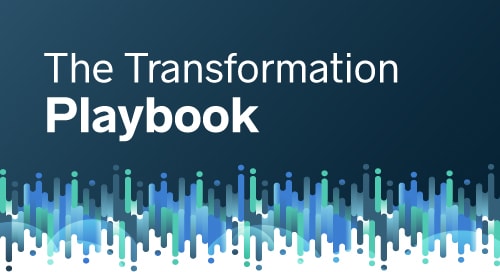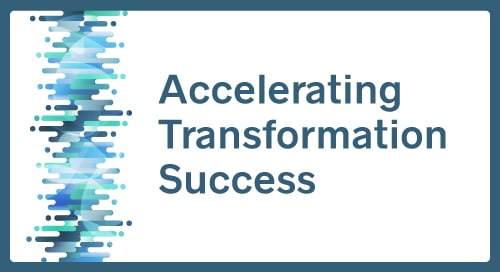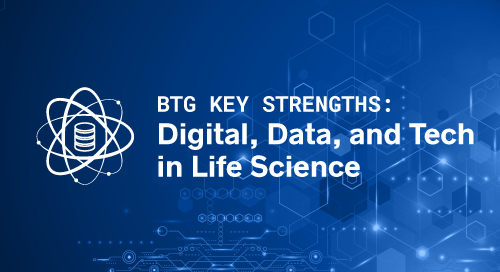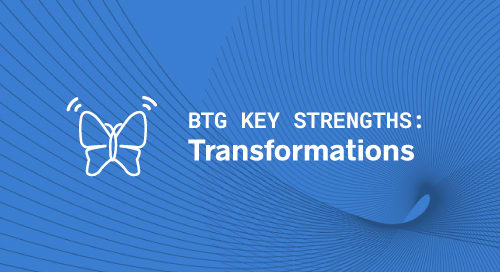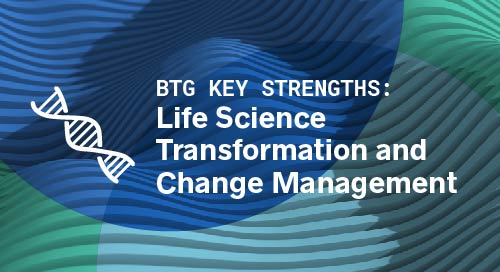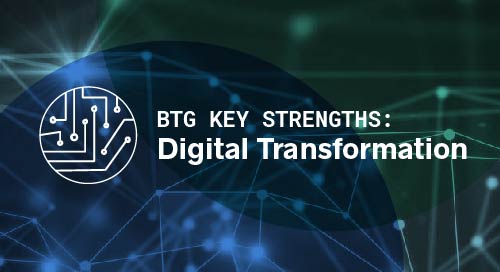
If you’re like most life science executives, you can’t go more than a few days without reading about new technologies that are poised to disrupt your business. You may have read about competitors who are committed to “going digital.” You may even have been tasked with exploring or leading a digital transformation at your own company.
But what does digital transformation mean for a life science company? In this edition of Business Talent Group’s Behind the Buzzword series, we unpack what people mean when they talk about “digital,” where the opportunities are, and how you can start to take advantage of them.
What is “digital?”
“Digital” was once an adjective. Now, it’s become short-hand for a slew of very different trends, techniques, and technologies: Artificial Intelligence, Machine Learning, Blockchain, (the analysis of) big data, changing customer expectations, changing business models, new sales channels, and new communication tools.
Not surprisingly, executives can talk about “going digital” and mean very different things.
We already use technology. Why do we have to go digital?
The life science industry has relied on data analysis for ages. But what’s driving the hype behind “digital” is scale. Imagine being able to leverage larger data sets about compounds and targets, more quickly and more easily, to drive insights that reduce time-to-market for new therapies, increase the personalization of key medicines, and boost operational efficiencies.
In an industry where product development is hard to do and harder to scale, it’s no surprise that companies have latched on to the transformative promise of this idea.
Where are the opportunities?
Impactful opportunities have emerged across the organization, throughout both R&D and commercial processes. New external partnerships make it easier to share insights and get access to best-in-class expertise. New data linkages and exchanges facilitate an easy flow of information between functions, powering real-time and predictive analytics that accelerate business decisions.
As you evaluate these opportunities, it can be tempting to think big. But the clearest wins with digital have been operational, not scientific. The closer you get to fundamental science and discovery, the harder it is to realize the benefits of these tools and technologies—at least, in a “corporate timeframe.”
Here are three specific areas that have seen early success:
- Conducting virtual trials: Digital tools can accelerate the selection of subjects across geographies and streamline the execution of clinical trials by making data collection easier for patients and trial sponsors.
- Forecasting in-development and in-line drug supply: Predictive algorithms make it easier to forecast demand, understand how different factors impact demand, and ultimately produce what is needed—thereby lowering COGS for both Development and Commercial operations.
- Reinventing target discovery: New analytical tools promise to greatly improve the efficiency of target discovery, helping researchers better link targets to a specific disease. Larger, multi-dimensional data sets are also more accessible than ever before. Efforts are quite recent, however, so it’s still not clear whether this success will ultimately constitute step change or just a gradual improvement.
What’s the best way to get started?
The technologies may be new, but the process for successfully creating and implementing business strategies is the same as ever. Those who follow a deliberate path in this rapidly evolving space will find it easier to cut through the noise and deliver progress against clearly definable goals. Carve out projects that can demonstrate merit quickly—even if they don’t sound as exciting—to gain support for larger initiatives. Develop and maintain progress against solid metrics and KPIs for each initiative.
Chances are, several functions and business units at your company have already undertaken different digital transformation initiatives. Catalog and consolidate these initiatives to boost your efficiency and free up resources.
Creating your digital roadmap while delivering on near-term goals can be daunting—but it doesn’t have to be. To learn more about how life science companies can develop effective digital strategies, download our latest eBook. Written by life science expert Thomas A. Collet, it’s filled with advice from industry leaders—and a 6-step checklist that enables analytics teams to benchmark their efforts against emerging best practices.
Where can I get more help?
You can also consider engaging an independent life science consultant to help with everything from building sustainable strategies to managing implementation, all while avoiding the hassle of a big consulting firm or distracting your team from their day-to-day priorities.
Get the Skills You Need
Thousands of independent consultants, subject matter experts, project managers, and interim executives are ready to help address your biggest business opportunities.
About the Author
More Content by Leah Hoffmann


